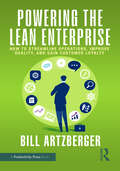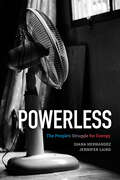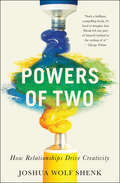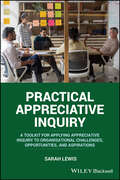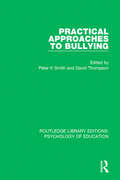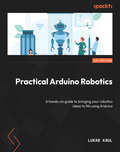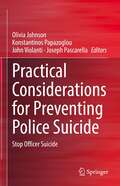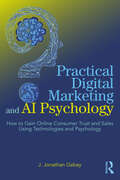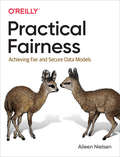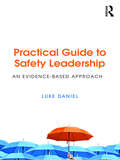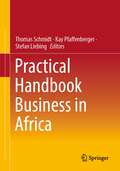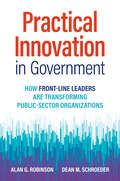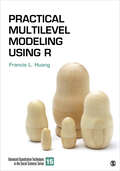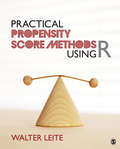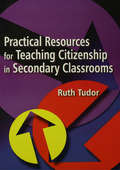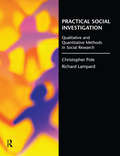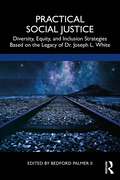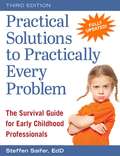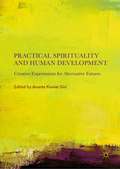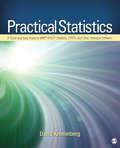- Table View
- List View
Powering the Lean Enterprise: How to Streamline Operations, Improve Quality, and Gain Customer Loyalty
by Bill ArtzbergerThe goal of Lean is to identify and eliminate nonessential and non-value-adding steps in business processes to streamline operations, improve quality, and gain customer loyalty. Implementation of Lean technologies for many prestigious Fortune 500 companies as well as smaller companies has netted larger profit margins, higher-quality products and services, improved employee engagement, increased customer satisfaction, and lower operating costs. The return on investment regarding Lean initiatives has been stellar. This book introduces basic Lean rules and principles in a variety of simulated case studies drawn from the author’s professional experiences as a Lean coach, trainer, and manager. In each instance, the author presents a different scenario for implementing Lean technologies.In this book, you will learn about:– Lean thinking– Lean mindset– The 4 Lean rules and 5 Lean principles– The Lean transformation roadmap– Lean leadership– Five common Lean pitfalls and how to avoid them– Kaizen workshops– Daily improvements and Kata
Powerless: The People's Struggle for Energy
by Diana Hernández Jennifer LairdEnergy serves as the lifeblood of our daily experiences. It permeates virtually every aspect of our existence, facilitating nourishment, safety, and productivity. When affordability threatens energy’s availability, a family’s living situation can become untenable—too cold, too hot, too dark, and too often, unhealthy and unsafe. In Powerless, sociologists Diana Hernández and Jennifer Laird reveal the hidden hardship of “energy insecurity” – the inability to adequately meet household energy needs. Approximately one in ten households in the U.S. are energy insecure and four in ten are at risk for energy insecurity. These statistics alone do not convey the acute pain of utility shutoffs, or the relentless toll of chronic energy hardships marked by difficult choices and harsh living conditions. Drawing on survey data and interviews with one hundred energy-insecure individuals and families, Hernández and Laird detail the experience of energy insecurity. Individuals and families suffering from energy insecurity endure economic hardships, such as difficulty paying utility bills, utility debt, and disconnection from utility services. They also struggle with physical challenges, such as poor housing conditions and poor or dysfunctional heating and cooling systems. They are often forced to make difficult choices about what bills to pay. These decisions are sometimes referred to as “heat or eat?” choices, as families cannot afford to pay for heating and food at the same time. Energy insecure individuals and families employ a variety of strategies to keep energy costs down to avoid having to make these hard choices. This includes deliberate underconsumption of energy, enduring physical discomfort, and using dangerous alternatives such as open flames, ovens, or space heaters to try to maintain a comfortable temperature in their home. To be energy insecure is to suffer. Despite the heavy toll of energy insecurity, most people confront these difficulties behind closed doors, believing it is a private matter. Thus, the enormous social crisis of energy insecurity goes unnoticed. Hernández and Laird argue that household energy is a basic human right and detail policies and practices that would expand access to consistent, safe, clean, and affordable energy. Their proposals include improving the current energy safety net, which is limited and often does not serve the most energy insecure due to stringent program requirements and administrative burdens. They also suggest redesigning rates to accommodate income, promoting enrollment and expansion of discount programs, reforming utility disconnection policies, improving energy literacy, and ensuring an equitable shift to renewable energy resources. Powerless creates a comprehensive picture of the complex social and environmental issue of energy insecurity and shows how energy equity is not just an aspiration but an achievable reality.
Powers of Pilgrimage: Religion in a World of Movement
by Simon ColemanFinalist, Award for Excellence in the Study of Religion, Analytical-Descriptive Studies, given by the American Academy of ReligionA groundbreaking reframing of religious pilgrimagePious processions. Sites of miraculous healing. Journeys to far-away sacred places. These are what are usually called to mind when we think of religious pilgrimage. Yet while pilgrimage can include journeying to the heart of sacred shrines, it can also occur in apparently mundane places. Indeed, not everyone has the resources or mobility to take part in religiously inspired movement to foreign lands, and some find meaning in religious movement closer to home and outside of officially sanctioned practices. Powers of Pilgrimage argues that we must question the universality of Western assumptions of what religion is and where it should be located, including the notion that “genuine” pilgrimage needs to be associated with discrete, formally recognized forms of religiosity. This necessary volume makes the case for expanding our gaze to reconsider the salience, scope, and scale of contemporary forms of pilgrimage and pilgrimage-related activity. It shows that we need to reflect on how pilgrimage sites, journeys, rituals, stories, and metaphors are entangled with each other and with wider aspects of people’s lives, ranging from an action as trivial as a stroll down the street to the magnitude of forced migration to another country or continent. Offering a new theoretical lexicon and framework for exploring human pilgrimage, Powers of Pilgrimage presents a broad overview of how we can understand pilgrimage activity and proposes that it should be understood not solely as going to, staying at, and leaving a sacred place, but also as occurring in ordinary times, places, and practices.
Powers of Two: How Relationships Drive Creativity
by Joshua Wolf ShenkThe power of collaboration, from Lennon and McCartney to Wozniak and Jobs: &“An inspiring book that also happens to be a great read&” (Daniel H. Pink, author of Drive). Throughout history, partners have buoyed each other to better work—though often one member is little known to the general public. (See Warren Buffett and Charlie Munger, or Vincent and Theo van Gogh.) Powers of Two draws on neuroscience, social psychology, and cultural history to present the social foundations of creativity, with the pair as its primary embodiment. Revealing the six essential stages through which creative intimacy unfolds, this book shows how pairs begin to talk, think, and even look like each other; how the most successful ones thrive on conflict; and why some cease to work together while others carry on. At once intuitive and deeply surprising, Powers of Two will reshape the way you view individuals, relationships, and society itself. &“A rare glimpse into the private realms of duos . . . A natural storyteller.&” —The New York Times &“A book about magic, about the Beatles, about the chemistry between people, about neuroscience, and about the buddy system; it examines love and hate, harmony and dissonance, and everything in between . . . Wise, funny, surprising, and completely engrossing.&” —Susan Orlean &“We sometimes think of creativity as coming from brilliant loners. In fact, it more often happens when bright people pair up and complement each other. Shenk&’s fascinating book shows how to spark the power of this phenomenon.&” —Walter Isaacson &“Surprising, compelling . . . Shenk banishes the idea of solitary genius by demonstrating that our richest art and science come from collaboration: we need one another not only for love, but also for thinking and imagining and growing and being.&” —Andrew Solomon
Practical Appreciative Inquiry: A Toolkit for Applying Appreciative Inquiry to Organisational Challenges, Opportunities, and Aspirations
by Sarah LewisCreate a shared vision built on core strengths and values to improve your organization Appreciative Inquiry (AI) equips leaders with a revolutionary approach to achieving positive organizational change. Rather than the traditional managerial method of first evaluating a problem and then proposing a solution, AI teaches you to ask, “What is going right here, and how can we grow more of it?” In Practical Appreciative Inquiry, expert organizational consultant and facilitator Sarah Lewis teaches you how to apply the AI methodology in an array of management situations. Step by step, this practice-oriented guide helps you leverage the versatility and flexibility of Appreciative Inquiry to make rapid, positive change. Covering all key aspects of AI, this concise yet comprehensive resource provides a wealth of ideas and activities designed to develop an AI leadership mindset, build resilience within your organization, motivate performance, increase team innovation, support change processes, create AI interventions, and much more. Each chapter features discussion questions, teaching exercises, links to online resources, and real-world case studies of AI in practice. Whether an experienced practitioner or a newcomer to change management, Practical Appreciative Inquiry: A Toolkit for Applying Appreciative Inquiry to Organisational Challenges, Opportunities, and Aspirations is a must-read for all leaders, managers, and team members wanting to improve their organization, as well as consultants, trainers, and organizational development experts interested in AI.
Practical Approaches to Bullying (Routledge Library Editions: Psychology of Education)
by David Thompson Peter K SmithOriginally published in 1991, this book is about bullying and victimisation in children and young people, and ways of dealing with it. With the exception of Chapter 13 which is related to experiences of bullying within the borstal system, superseded by Youth Custody and more recently the Unified Custodial Sentence, it is about bullying in schools. The aim of this book is to help teachers, school governors, and parents work towards reducing the effects of behaviour which can, at worst, blight the lives of victims into adulthood and encourage antisocial and violent behaviour in those who get away with bullying.
Practical Arduino Robotics: A hands-on guide to bringing your robotics ideas to life using Arduino
by Lukas KaulBuild your hardware, electronics, and programming skills, and use them to realize your advanced robotics projects with this powerful platformPurchase of the print or Kindle book includes a free PDF eBookKey FeaturesBecome an expert in selecting sensors, motors, and Arduino boards for any robotics projectDiscover how to write effective and reusable code for your Arduino robotics projectsLearn to build a camera-based line follower and a self-balancing telepresence robot on your ownBook DescriptionEvery robot needs a “brain,” and the Arduino platform provides an incredibly accessible way to bring your Arduino robot to life. Anyone can easily learn to build and program their own robots with Arduino for hobby and commercial uses, making Arduino-based robots the popular choice for school projects, college courses, and the rapid prototyping of industrial applications!Practical Arduino Robotics is a comprehensive guide that equips you with the necessary skills and techniques that can be applied to various projects and applications, from automating repetitive tasks in a laboratory to building engaging mobile robots.Building on basic knowledge of programming and electronics, this book teaches you how to choose the right components, such as Arduino boards, sensors, and motors, and write effective code for your robotics project, including the use of advanced third-party Arduino libraries and interfaces, such as Analog, SPI, I2C, PWM, and UART. You'll also learn different ways to command your robots wirelessly, such as over Wi-Fi. Finally, with basic to advanced project examples, this book illustrates how to build exciting autonomous robots like a self-balancing telepresence robot.By the end of this book, you'll be able to design and create your own custom robots for a wide variety of applications.What you will learnUnderstand and use the various interfaces of an Arduino boardWrite the code to communicate with your sensors and motorsImplement and tune methods for sensor signal processingUnderstand and implement state machines that control your robotImplement feedback control to create impressive robot capabilitiesIntegrate hardware and software components into a reliable robotic systemTune, debug, and improve Arduino-based robots systematicallyWho this book is forIf you're excited about robotics and want to start creating your own robotics projects from the hardware up, this book is for you. Whether you are an experienced software developer who wants to learn how to build physical robots, a hobbyist looking to elevate your Arduino skills to the next level, or a student with the desire to kick-start your DIY robotics journey, you'll find this book very useful. In order to successfully work with this book, you'll need basic familiarity with electronics, Arduino boards and the core concepts of computer programming.
Practical Arduino Robotics: A hands-on guide to bringing your robotics ideas to life using Arduino
by Lukas KaulBuild your hardware, electronics, and programming skills, and use them to realize your advanced robotics projects with this powerful platform Purchase of the print or Kindle book includes a free PDF eBookKey FeaturesBecome an expert in selecting sensors, motors, and Arduino boards for any robotics projectDiscover how to write effective and reusable code for your Arduino robotics projectsLearn to build a camera-based line follower and a self-balancing telepresence robot on your ownBook DescriptionEvery robot needs a “brain,” and the Arduino platform provides an incredibly accessible way to bring your Arduino robot to life. Anyone can easily learn to build and program their own robots with Arduino for hobby and commercial uses, making Arduino-based robots the popular choice for school projects, college courses, and the rapid prototyping of industrial applications! Practical Arduino Robotics is a comprehensive guide that equips you with the necessary skills and techniques that can be applied to various projects and applications, from automating repetitive tasks in a laboratory to building engaging mobile robots. Building on basic knowledge of programming and electronics, this book teaches you how to choose the right components, such as Arduino boards, sensors, and motors, and write effective code for your robotics project, including the use of advanced third-party Arduino libraries and interfaces, such as Analog, SPI, I2C, PWM, and UART. You'll also learn different ways to command your robots wirelessly, such as over Wi-Fi. Finally, with basic to advanced project examples, this book illustrates how to build exciting autonomous robots like a self-balancing telepresence robot. By the end of this book, you'll be able to design and create your own custom robots for a wide variety of applications.What you will learnUnderstand and use the various interfaces of an Arduino boardWrite the code to communicate with your sensors and motorsImplement and tune methods for sensor signal processingUnderstand and implement state machines that control your robotImplement feedback control to create impressive robot capabilitiesIntegrate hardware and software components into a reliable robotic systemTune, debug, and improve Arduino-based robots systematicallyWho this book is forIf you’re excited about robotics and want to start creating your own robotics projects from the hardware up, this book is for you. Whether you are an experienced software developer who wants to learn how to build physical robots, a hobbyist looking to elevate your Arduino skills to the next level, or a student with the desire to kick-start your DIY robotics journey, you’ll find this book very useful. In order to successfully work with this book, you’ll need basic familiarity with electronics, Arduino boards and the core concepts of computer programming.
Practical Considerations for Preventing Police Suicide: Stop Officer Suicide
by Konstantinos Papazoglou Olivia Johnson John Violanti Joseph PascarellaThis book takes an in-depth look at the phenomenon of police officer suicide. Centered on statistical information collected from cases of officer suicide from 2017 to 2019, this volume helps readers understand the circumstances surrounding death by suicide amongst law enforcement personnel and makes recommendations for identification and prevention. Through interview and case presentations, this volume examines the lives and last days and weeks of several officers, using findings from social media, departmental surveys, medical examiner reports, toxicology reports and interviews with loved ones and colleagues to create a psychological autopsy. With 14 chapters contributed by former law enforcement, researchers, and mental health professionals, it addresses national, state, and local policy implications and strategies, presenting a theory for better understanding and preventing the phenomenon of officer suicide. This volume will be of interest to researchers in policing, to law enforcement and first responder leadership and administrative professionals, and to mental health practitioners and clinicians working with this unique population
Practical Digital Marketing and AI Psychology: How to Gain Online Consumer Trust and Sales Using Technologies and Psychology
by J. Jonathan GabayPractical Digital Marketing and AI Psychology explores how successful brands utilise both psychology and cutting-edge artificial intelligence technologies to maximise digital marketing strategies.Psychology has long been a foundation for successful marketing strategies, and evolving AI technologies are opening up new opportunities for marketers to help brands build trust and loyalty online. In this exceptional book, award-winning writer Jonathan Gabay delves into fascinating psychological digital marketing techniques and concepts, explaining the practical psychology and science you need to lift your marketing career to the next level. Gabay explores how new technologies can be harnessed to increase their impact significantly. The book provides practical tips and contemporary best-practice examples, including prompt engineering, the psychology behind mission statements and logo design, gamification, the possibilities and pitfalls of social media, among many more areas that will ensure your brand is trusted, valued, and desired.This definitive book is perfect for marketing students up to PhD level and digital marketing, PR, and sales professionals looking for a fascinating, compelling read, packed with ideas and examples, that combines academic excellence with practical advice – all written and presented in a highly accessible style.
Practical Fairness: Achieving Fair And Secure Data Models
by Aileen NielsenFairness is an increasingly important topic as machine learning and AI more generally take over the world. While this is an active area of research, many realistic best practices are emerging at all steps along the data pipeline, from data selection and preprocessing to blackbox model audits. This book will guide you through the technical, legal, and ethical aspects of making your code fair and secure while highlighting cutting edge academic research and ongoing legal developments related to fairness and algorithms.There is mounting evidence that the widespread deployment of machine learning and artificial intelligence in business and government is reproducing the same biases we are trying to fight in the real world. For this reason, fairness is an increasingly important consideration for the data scientist. Yet discussions of what fairness means in terms of actual code are few and far between. This code will show you how to code fairly as well as cover basic concerns related to data security and privacy from a fairness perspective.
Practical Guide to Safety Leadership: An Evidence-Based Approach
by Luke DanielLeaders can shape an organisation through their behaviours and their vision. If an organisation lacks a clear vision or there is disengagement by the leadership team, then the results can be disastrous. In such circumstances change is needed. When change is needed, the value of safety can become a change agent. From the disciplines of leadership and safety comes the emerging topic of safety leadership. Through safety leadership, workplace challenges can be rectified and the desired behaviours reinforced. These challenges can span from a lack of leadership engagement, poor safety performance, complacency or lack of safety ownership. Understanding how safety leadership differs from other leadership theories can give you a competitive edge which is not solely based upon financial quotas, but instead based upon the moral code of ensuring the health and well-being of your employees. This book goes beyond mere safety slogans or anecdotal stories that relate to safety leadership. Instead an empirical and research-based approach will be shared which can help improve the overall culture of an organisation as well as the safety of employees. Tools, case studies, theories and practical applications will be shared which can help create the blueprint for organisational change that you seek. Even when things are working well, constant innovation and adoption of best practices can help companies go from good to great and leave a lasting legacy for employees and customers alike. Detailing the mechanics of safety leadership, this book will drive the change and results you want.
Practical Handbook Business in Africa
by Thomas Schmidt Kay Pfaffenberger Stefan LiebingAfrica is a continent on the upswing, developing great economic momentum. If German companies want to participate in Africa's upswing, they need to be familiar with some special features. This book shows the way to successful business in Africa. It is a practical, yet scientifically based guide for all entrepreneurs and economically interested parties who want to be successful in Africa. It combines the experience of many companies with the scientific perspective and findings of the Centre for Business and Technology in Africa at Flensburg University of Applied Sciences.In the 2nd edition new developments on the African continent are taken up and current answers are given to the classical questions, which each actor must answer for itself, which wants to be economically successful in Africa: WHY Africa is interesting for the business, WHERE the largest chances of success exist, HOW to proceed and WHICH approaches for the future organization of the economic relations between Germany and Africa are promising.The book describes how to invest in Africa and bundles the current experiences of managers of large corporations and family businesses with a long history on the continent.
Practical Innovation in Government: How Front-Line Leaders Are Transforming Public-Sector Organizations
by Dean M. Schroeder Alan G RobinsonThis book is a comprehensive guide to an exciting new approach that managers at any level can use to transform their corners of government.Whether people want more government or less, everyone wants an efficient government. Traditional thinking is that this requires a government to be run more like a business. But a government is not a business, and this approach merely replaces old problems with new ones.In their six-year, five-country study of seventy-seven government organizations-ranging from small departments to entire states-Alan Robinson and Dean Schroeder found that the predominant private-sector approaches to improvement don't work well in the public sector, while practices that are rare in the private sector prove highly effective. The highest performers they studied had attained levels of efficiency that rivaled the best private-sector companies.Rather than management making the improvements, as is the norm in the private sector, these high-performers focused on front-line-driven improvement, where most of the change activity was led by supervisors and low-level managers who unleashed the creativity and ideas of their employees to improve their operations bit by bit every day.You'll discover how Denver's Department of Excise and Licenses reduced wait times from an hour and forty minutes to just seven minutes; how the Washington State Patrol garage tripled its productivity and became a national benchmark; how a K8 school in New Brunswick, Canada, boosted the percentage of students reading at the appropriate age level from 22 percent to 78 percent; and much more.
Practical Multilevel Modeling Using R (Advanced Quantitative Techniques in the Social Sciences)
by Francis L. HuangPractical Multilevel Modeling Using R provides students with a step-by-step guide for running their own multilevel analyses. Detailed examples illustrate the conceptual and statistical issues that multilevel modeling addresses in a way that is clear and relevant to students in applied disciplines. Clearly annotated R syntax illustrates how multilevel modeling (MLM) can be used, and real-world examples show why and how modeling decisions can affect results. The book covers all the basics but also important advanced topics such as diagnostics, detecting and handling heteroscedasticity, power analysis, and missing data handling methods. Unlike other detailed texts on MLM which are written at a very high level, this text with its applied focus and use of R software to run the analyses is much more suitable for students who have substantive research areas but are not training to be methodologists or statisticians. Each chapter concludes with a "Test Yourself" section, and solutions are available on the instructor website for the book. A companion R package is available for use with this text.
Practical Multilevel Modeling Using R (Advanced Quantitative Techniques in the Social Sciences)
by Francis L. HuangPractical Multilevel Modeling Using R provides students with a step-by-step guide for running their own multilevel analyses. Detailed examples illustrate the conceptual and statistical issues that multilevel modeling addresses in a way that is clear and relevant to students in applied disciplines. Clearly annotated R syntax illustrates how multilevel modeling (MLM) can be used, and real-world examples show why and how modeling decisions can affect results. The book covers all the basics but also important advanced topics such as diagnostics, detecting and handling heteroscedasticity, power analysis, and missing data handling methods. Unlike other detailed texts on MLM which are written at a very high level, this text with its applied focus and use of R software to run the analyses is much more suitable for students who have substantive research areas but are not training to be methodologists or statisticians. Each chapter concludes with a "Test Yourself" section, and solutions are available on the instructor website for the book. A companion R package is available for use with this text.
Practical Propensity Score Methods Using R
by Walter L. LeiteThis practical book uses a step-by-step analysis of realistic examples to help students understand the theory and code for implementing propensity score analysis with the R statistical language. With a comparison of both well-established and cutting-edge propensity score methods, the text highlights where solid guidelines exist to support best practices and where there is scarcity of research. Readers will find that this scaffolded approach to R and the book’s free online resources help them apply the text’s concepts to the analysis of their own data.
Practical Propensity Score Methods Using R
by Walter L. LeiteThis practical book uses a step-by-step analysis of realistic examples to help students understand the theory and code for implementing propensity score analysis with the R statistical language. With a comparison of both well-established and cutting-edge propensity score methods, the text highlights where solid guidelines exist to support best practices and where there is scarcity of research. Readers will find that this scaffolded approach to R and the book’s free online resources help them apply the text’s concepts to the analysis of their own data.
Practical Resources for Teaching Citizenship in Secondary Classrooms
by Ruth TudorBased on the New Curriculum for Citizenship, this book provides practitioners in secondary schools with the essential tools needed to teach citizenship. The authors provide an overview of the citizenship order and give guidance on how to fulfill its three main elements: social and moral responsibility, community involvement and political literacy. The book focuses on curriculum developments, teaching, learning and assessment issues and includes a rationale for planning schemes of work in citizenship for the whole school. It also includes lesson plans, teaching ideas and resources, and step-by-step guidance on assessment. Emphasis is placed on including all pupils and references are made to cross-curricular links with other subjects.
Practical Social Investigation: Qualitative and Quantitative Methods in Social Research
by Christopher Pole Richard LampardPractical Social Investigation provides, within a single text, an introduction to a wide range of both long-standing and newer social research methods. Its balanced and integrated coverage of qualitative and quantitative approaches demonstrates that they can be complementary. While research practice is emphasised, readers are encouraged to reflect on methodological issues as well as being provided with tools for their own research.This coherent, accessibly written book draws upon the authors' extensive experience of conducting research and teaching research methods. Numerous examples, based on real research studies, illustrate key issues in a way that acknowledges both the messiness and the creativity of social research.
Practical Social Justice: Diversity, Equity, and Inclusion Strategies Based on the Legacy of Dr. Joseph L. White
by Bedford Palmer IIPractical Social Justice brings together the mentorship experiences of a diverse group of leaders across business, academia, and the public sector. They relay the lessons they learned from Dr. Joseph L. White through personal narratives, providing a critical analysis of their experience, and share their best practices and recommendations for those who want to truly live up to their potential as leaders and mentors. As one of the founding members of the Association of Black Psychologists, the Equal Opportunity Program, and the ‘Freedom Train’ this book focuses on celebrating Dr. White’s legacy, and translating real world experience in promoting social justice change. Experiential narratives from contributors offer a framework for both the mentee and the mentor, and readers will learn how to develop people and infrastructure strategically to build a sustainable legacy of social justice change. They will be presented with ways to pragmatically focus social justice efforts, favoring results over ego. This is a unique and highly accessible book that will be useful across disciplines and generations, in which the authors illustrate how to build relationships, inspire buy-in, and develop mutually beneficial partnerships that move people and systems towards a more equitable, inclusive, and just future. Providing a personal guide to developing an infrastructure for institutional change, Practical Social Justice is based on over half a century of triumph, translated through the lenses of leaders who have used these lessons to measurable and repeatable success. This book will be essential reading for undergraduate and graduate students in the fields of Psychology, Social Work, Ethnic Studies, Sociology, Public Policy, Leadership, Communications, Business, and Educational Administration. It is also important reading for professionals including leaders and policy makers in organisations dealing with issues around diversity, equity, and inclusion, and anyone interested in promoting social justice.
Practical Solutions to Practically Every Problem: The Survival Guide for Early Childhood Professionals
by Steffen SaiferAn encyclopedic how-to guide for the universal early childhood program problems.Practical Solutions to Practically Every Problem attempts to provide solutions to every possible problem faced by early childhood teachers-before teachers encounter them. This classic resource has been updated to focus on current issues faced by educators, including teaching twenty-first century life skills, technology, and cultural responsiveness. This easy-to-use guide gives you quick practical help, now!Educators will save time and energy with over eight hundred solutions to two hundred problems, including:Daily dilemmas and classroom issuesPartnering with families to raise happy childrenDealing with problematic behaviors from co-workersLearning to take care of yourself to prevent burn-outSteffen Saifer, EdD, a former early childhood teacher and Head Start director and trainer, is currently an international consultant and writer based in Spain. He has worked on projects for the Open Society Foundation, The World Bank, and UNICEF, in many countries including Bangladesh, Russia, and Zimbabwe. Dr. Saifer works with programs on culturally responsive curriculum development and implementation and with universities to develop graduate programs for ECD teachers, administrators, and leaders. When in the United States, Saifer resides in Portland, Oregon
Practical Speech User Interface Design (Human Factors and Ergonomics)
by James R. LewisAlthough speech is the most natural form of communication between humans, most people find using speech to communicate with machines anything but natural. Drawing from psychology, human-computer interaction, linguistics, and communication theory, Practical Speech User Interface Design provides a comprehensive yet concise survey of practical speech
Practical Spirituality and Human Development: Creative Experiments for Alternative Futures
by Ananta Kumar GiriThis book explores varieties of spiritual movements and alternative experiments for the generation of beauty, dignity and dialogue in a world where the rise of the religious in politics and the public sphere is often accompanied by violence. It examines how spirituality can contribute to human development, social transformations and planetary realizations, urging us to treat each other, and our planet, with evolutionary care and respect. Trans-disciplinary and trans-paradigmatic to its very core, this text opens new pathways of practical spirituality and humanistic action for both scholarship and discourse and offers an invaluable companion for scholars across religious studies, cultural studies and development studies.
Practical Statistics: A Quick and Easy Guide to IBM® SPSS® Statistics, STATA, and Other Statistical Software
by David KremelbergMaking statistics—and statistical software—accessible and rewarding This book provides readers with step-by-step guidance on running a wide variety of statistical analyses in IBM® SPSS® Statistics, Stata, and other programs. Author David Kremelberg begins his user-friendly text by covering charts and graphs through regression, time-series analysis, and factor analysis. He provides a background of the method, then explains how to run these tests in IBM SPSS and Stata. He then progresses to more advanced kinds of statistics such as HLM and SEM, where he describes the tests and explains how to run these tests in their appropriate software including HLM and AMOS. This is an invaluable guide for upper-level undergraduate and graduate students across the social and behavioral sciences who need assistance in understanding the various statistical packages.
